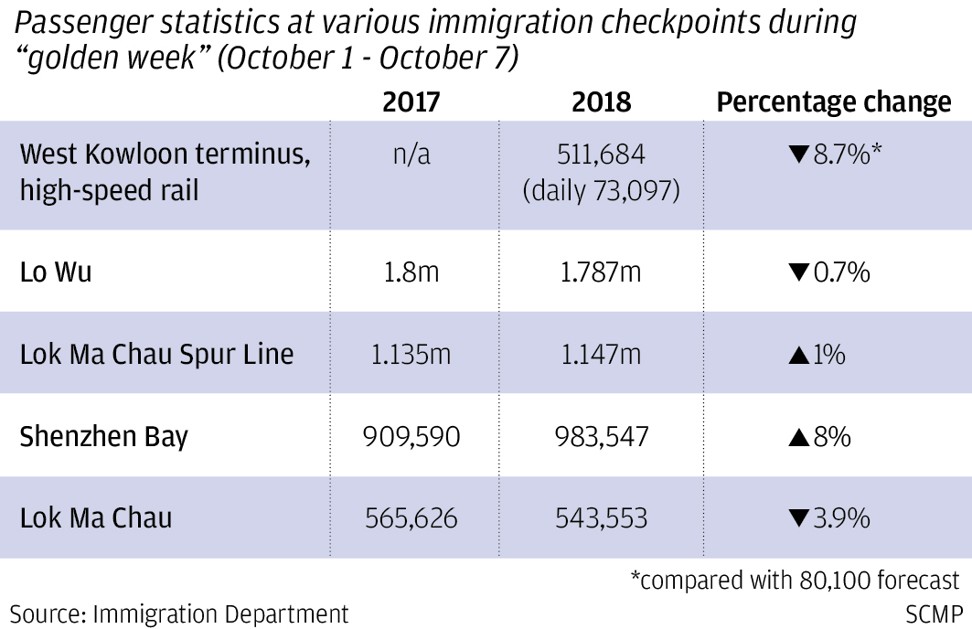
Has cross-border high-speed rail created new pool of visitors to Hong Kong as ‘golden week’ arrivals jump 20 per cent?
Data shows traffic at major checkpoints largely unchanged over seven-day holiday, but visitor numbers rise to 1.5 million
But critics said the visitors were largely drawn by the Guangzhou-Shenzhen-Hong Kong Express Rail Link’s newness and warned it would run into deficit if it failed to boost cross-border travel during low-turnout weekdays.
From its launch on September 23 to the end of the month, an average of 46,600 passengers passed through the immigration checkpoint at Hong Kong’s West Kowloon terminal daily.

For the week-long break, which started on National Day on October 1, on average about 73,000 commuters took the rail link each day, 8.7 per cent below the government’s conservative estimate of 80,100 daily. On Friday, the number hit a high of 80,020.
60,000 mainlanders enter Hong Kong on high-speed rail – in just one day
However, government data showed cross-border traffic at major checkpoints was not adversely affected by the rail link over the holiday while the number of mainland visitors coming to Hong Kong soared 20 per cent to 1.5 million, compared with 1.27 million during the same period last year.
According to government figures, the number of travellers passing through the Lo Wu border checkpoint remained almost the same at 1.79 million, with 1.15 million using the Lok Ma Chau Spur Line control point, compared with 1.8 million and 1.13 million respectively last year.
The Shenzhen Bay checkpoint saw an 8 per cent rise in passenger numbers.
The most visible impact of the high-speed rail was at the Lok Ma Chau checkpoint, the common route for cross-border coaches. Over the past week, 543,553 commuters crossed this checkpoint, down almost 4 per cent from 565,626 last year.
Quentin Cheng Hin-kei, spokesman for concern group Public Transport Research Team, maintained his gloomy forecast for the express rail, insisting it was doomed to run deficits.
“The figures have proved my analysis that the high-speed rail link won’t have any impact on the passenger flows at other checkpoints as its mainland stations are not located in convenient places and the timetables are also not accommodating,” he said.
“If the national golden week still failed to enable the rail link to garner enough passengers to meet its target, it’s not hard to imagine its patronage during weekdays. When this sense of freshness is worn out, it will be difficult to attract visitors.”
He said there would be a clear picture of the rail’s business outlook after the Lunar New Year.
Tourism sector lawmaker Yiu Si-wing blamed complicated ticketing procedures, which deterred travel agencies from launching more tour groups and products, for the low numbers on weekdays.
‘Golden week’: 1.2 million mainlanders throng city but high-speed rail link still underperforms
“So far there has not been sentiment for high-speed rail tours because the ticketing process is not convenient for travel agents. The MTR Corp must simplify the ticketing procedures to give greater convenience and power to local agents,” he said.


